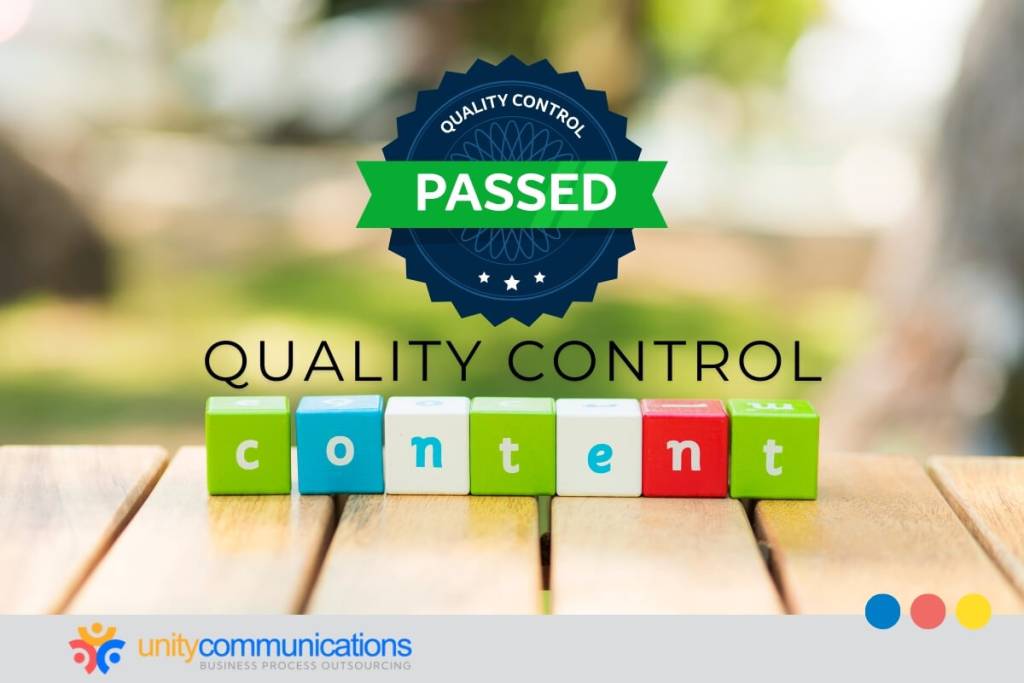Table of Contents
Outsourcing provides a strategic approach to streamlining content production. However, ensuring consistency and quality are key to maximizing business process outsourcing (BPO).
Content quality control in outsourcing safeguards brand integrity, boosts user engagement, and aligns with your company’s vision. Keep reading to learn how robust quality control processes can improve your outsourced content, enhance accuracy and results, and drive measurable marketing results.
Importance of quality control in content outsourcing

What is BPO, and how can you leverage the strategy for success? BPO entails assigning non-core operations to a service provider to access its specialized resources, enhance efficiency, and drive results.
Maintaining a brand reputation in content outsourcing depends on quality control. For business-to-business (B2B) or business-to-consumer (B2C) markets, aligning outsourced content with the brand’s vision is crucial for consistency and impact.
Examine why you should prioritize content quality control in outsourcing:
- Safeguarding brand integrity: Consistent, high-quality content reflects a professional image and builds trust with the intended audience. Research by the Content Marketing Institute shows that 77% of top B2B marketers surveyed credit their success in content marketing to producing high-quality copy.
- Enhancing user engagement: Quality content tailored to the user experience (UX) increases audience interaction and satisfaction.
- Navigating cultural sensitivities: A robust quality control system considers the cultural nuances of diverse markets.
- Streamlining collaboration: Working with an offshore third-party company that understands the importance of quality contributes to a smooth, efficient outsourcing partnership.
- Leveraging artificial intelligence (AI) and machine learning (ML): Integrating these technologies into quality control boosts accuracy and consistency. Based on Semrush’s survey of over 2,600 businesses, 79% reported improved content quality through AI use.
Setting clear content guidelines and expectations
Transparent, detailed guidelines help retain consistency and quality when outsourcing. By outlining content requirements, your business and its BPO partner can align the work with brand objectives so it meets expectations and resonates with the target audience. Setting the guidelines makes content quality control in outsourcing more manageable.
Consider the primary components to include in your content guidelines:
- Tone and voice: Define whether the tone should be professional, casual, or friendly to maintain a consistent voice across all content.
- Style guidelines: Specify grammar rules, sentence structure, and preferred formatting for uniformity.
- Search engine optimization (SEO) considerations: Optimize content for search engines, especially Google, including targeting keywords, meta tags, and internal and external linking. Google dominates the search engine market, processing over 60% of all search inquiries in the United States.
- Brand goals: Align content with overarching business objectives, ensuring it supports marketing campaigns and engages the correct audience.
- Types of content: Outline the specific formats corresponding to your brand strategy, including blogs, videos, and social media posts. This step simplifies production and sustains consistency.
Selecting outsourcing partners
A Siege Media survey reveals that 90% of companies outsource at least part of their content marketing strategies. However, success relies on partner quality. Outsourcing won’t be worthwhile regardless of investment if the BPO partner doesn’t deliver results.
Select the ideal service provider for effective partnership and content outcomes with these factors:
- Industry expertise: The third-party contractor’s industry expertise helps deliver accurate, relevant content that upholds your brand’s professionalism and quality standards.
- Technology: Evaluate the outsourcing firm’s use of online platforms and tools that streamline content production. These technologies can facilitate real–time collaboration, helping to continually improve content quality.
- Quality assurance processes: A robust quality control system promotes consistent, high-standard content. Content quality control in outsourcing positions every piece to reflect your brand’s goals and audience expectations.
- Scalability: The BPO organization should scale to meet growing content needs, whether handling large amounts of user-generated content or expanding reach. Adaptability is crucial to sustainability.
Using tools for quality assurance and content review
Content tools improve quality, maintain consistency, and reduce errors. Examples include:
- Grammarly or ProWritingAid for grammar checks
- Copyscape or Turnitin for plagiarism detection
- Yoast SEO or Semrush for keyword research and readability
- Microsoft Word or Google Docs for formatting, including table of contents
These platforms streamline content review, act as a second set of eyes to help meet quality standards, and make content quality control in outsourcing more manageable.
Human moderators are still crucial for verifying nuanced content quality. Combining these technologies with skilled BPO reviewers creates a comprehensive solution for maintaining high-quality content.
Social media platforms, a critical aspect of content moderation, also benefit from outsourcing. The advantages of outsourcing content moderation include quick response times and the effective handling of large amounts of user-generated content. The benefits of outsourcing content moderation also extend to scalability and access to a global pool of experts.
Implementing a structured feedback process

Explicit review and input loops promote collaboration, improve performance, and align content with brand goals. They optimize content quality control in outsourcing because both teams understand their roles and expectations.
Below are the vital aspects of an effective feedback process:
- Clear review protocols: Determine who reads the content, how feedback is provided, and the timetable for modifications. This helps teams communicate more efficiently and enhances the content workflow.
- Timely and helpful comments: Feedback should be actionable and supplied promptly to avoid delays in content delivery. It should emphasize content improvement and constructive insights rather than simply pointing out errors.
- Ongoing revisions: Incorporating feedback in numerous rounds refines the material and offers consistency with the brand’s voice and objectives.
- Collaboration between the internal team and the BPO vendor: Frequent communication between in-house and third-party teams fosters a cohesive content development, management, and optimization strategy.
- Feedback documentation: Recording feedback reduces misunderstandings, maintains consistency between revisions, and supports long-term content quality improvement.
Ensuring brand voice consistency in outsourced content
Sustaining a consistent brand voice in outsourced content strengthens your brand’s identity and messaging. A unified tone and style help your firm appear trustworthy and professional. Strategies to execute this include:
- Sample content libraries: Give examples of previous content that matches your brand’s tone and messaging. These samples serve as references for the BPO team and help maintain style.
- Platform-specific modifications: Confirm that your outsourced material, whether social media postings, blog pieces, product descriptions, or email campaigns, is consistent with the tone and meets the channel’s requirements. This supports platform-appropriate content delivery.
- Brand ambassadors: Assign internal team members to serve as brand ambassadors, connecting directly with the third-party team. They can provide content direction and monitor quality.
- Content audits: Regularly evaluate any outsourced content for inconsistencies or deviations from your brand voice, allowing for revisions, continuous enhancements, and alignments with changing brand objectives.
- Use content management tools: Solutions, including content management systems (CMS) or collaborative platforms, offer centralized access to guidelines and feedback, allowing quick reference and consistency.
Monitoring and evaluating content performance
Tracking performance is critical for assessing content’s impact and improving outsourced output. With these strategies, content quality control in outsourcing becomes an ongoing effort. This results in data-driven improvements and alignment with larger goals.
Here’s how you can efficiently monitor content performance:
Engagement metrics
User engagement reveals how well your content connects with the audience. Metrics include:
- Click-through rates (CTR) gauge the effectiveness of headlines and call-to-actions.
- Time on page tracks how long visitors stay, indicating content engagement.
- Social shares and comments reflect audience interaction and the content’s relevance.
SEO performance
Monitor key SEO metrics to assess your content’s impact on site visibility:
- Organic traffic indicates the visitors arriving at your site through search engines.
- Keyword rankings show how effectively your content performs for targeted search terms.
- Backlink quality and quantity reveal the content’s authority and ability to attract credible links.
Overall impact
Analyze the broader business impact by evaluating the following:
- Conversion rates show how your content drives actions, including sign-ups or purchases.
- Customer feedback offers insights into your content’s impact on satisfaction and brand perception.
Handling revisions and resolving quality issues
Managing content revisions and addressing quality concerns improve output delivery and meet brand expectations. A structured approach promotes consistency and reduces production delays.
Take these pointers to help handle revisions and resolve quality issues:
- Revision tracking: Use collaborative tools to track revisions, monitor changes, and maintain a history of edits for reference.
- Dedicated quality control team: Assign a team to oversee reviews and catch errors before approval. The members can contribute well to content quality control in outsourcing, including aligning content with required standards.
- Escalation protocol: Establish a clear guideline for escalating unresolved issues to efficiently address significant quality concerns and prevent recurring problems.
- Pre-approval samples: Request initial drafts before full production to allow early feedback and avoid large-scale revisions later.
- Standardized templates: Provide templates for content creation to minimize discrepancies and promote consistent outputs from the BPO team.
- Quality benchmarks: Set specific measures to help evaluate content performance objectively and identify areas needing refinement.
- Post-delivery review: Conduct thorough post-delivery checks, incorporating stakeholder feedback to refine future projects.
Training and onboarding the BPO team

Onboarding and training your third-party professionals help align them with your brand’s values, content expectations, and workflows. A well-prepared BPO team can significantly improve content quality and audience impact.
Consider the following best practices to uphold content quality control in outsourcing:
- Brand immersion: Introduce the external specialists to your brand’s history, mission, and values to help them produce content authentically representing your brand.
- Workflow orientation: Familiarize the third-party BPO team with your internal processes and communication channels. A structured workflow reduces turnaround times.
- Review mechanism: Set structured feedback for content review and critique, strengthening the partnership between internal and BPO teams.
- Performance benchmarks: Set clear standards to track progress and identify areas for development. Regular monitoring fosters accountability and high-quality results.
- Cultural sensitivity training: Equip the BPO team with knowledge of cultural nuances so content resonates globally.
- Tool proficiency: Confirm the third-party professionals are proficient in your tools and platforms for better content management.
- Collaboration with internal experts: Foster collaboration with internal subject-matter experts for authoritative content.
Measuring the success of outsourced content strategies
Evaluating outsourced content performance helps you gauge its impact and optimize strategies accordingly. Here are some methods for measuring success:
- Performance metrics: Follow traffic, engagement, and conversions to determine content impact.
- Return on investment analysis: Estimate revenue by comparing content production expenses to post earnings.
- Audience feedback: Collect customer input and insights to understand whether the publications attract your target audience.
- Bounce rate: Count the number of visitors that leave the page without interacting to calculate content engagement.
- Conversion rates: Determine how the posts lead to desired actions (e.g., sign-ups or purchases).
- Organic search rankings: Track keyword ranking progress to assess SEO performance.
- Social sharing and engagement: To evaluate viral potential, quantify the frequency with which content is shared or remarked on.
- Customer retention: Measure long-term success by examining how content promotes repeat visits and engagement.
- Media mentions: Track how frequently your content is referenced in other content to gauge its influence.
- Video views: Measure video content’s number of views or completion rates to evaluate audience interest.
The bottom line
Delivering high-quality content necessitates solid oversight in third-party partnerships. By prioritizing content quality control in outsourcing, your company can maintain consistency, protect brand integrity, and increase audience engagement. Focusing on this approach improves content performance and aligns with brand goals.
If you’re ready to refine your content strategy through effective outsourcing, let’s connect and discuss how we can help you maintain high standards and achieve measurable outcomes.




